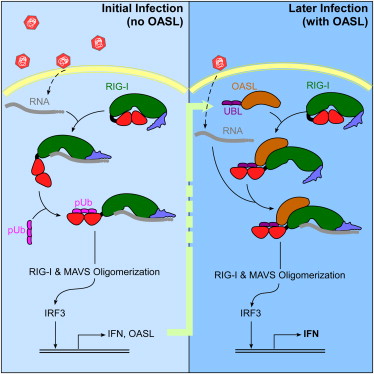Viral infections could be stopped by boosting natural protein
An international research team has published results showing that boosting the protein OASL may help the body to detect and fend off certain viral infections on its own. The discovery could lead to new, more effective treatments for many dangerous viruses such as hepatitis C and influenza.

It was initially thought that the immune system is all we have to protect against invasion – the one that makes antibodies and T-cells that can essentially destroy infected cells. Every cell has an intrinsic ability to detect viruses and then mount a cellular resistance.
The protein OASL (oligoadenylate synthetases-like) was discovered at the Department of Molecular Biology and Genetics at Aarhus University in 1998. It is a key component of the body's innate immune system, which – as a subsystem of the overall immune system – gives our cells the opportunity to defend themselves against pathogenic organisms.
OASL plays an important role in a process known as RNA sensing. Hepatitis C, influenza and many other viruses are known as ribonucleic acid (RNA) viruses as their genome consists of RNA. When these viruses infect cells, the viral RNA is released in the cell, whereby the virus can take over the cell, replicate and form new viruses. The viral RNA is detected in the cell as foreign and can be recognised by cellular proteins, including the important protein RIG-I.
The researchers discovered that OASL interacting with RIG-I acts as a sensing mechanism that detects foreign RNA within cells and warns other cells of the presence of the virus. This causes the other cells to activate the innate immune system so that they can better detect the virus and prevent its spread.
The only problem is that it takes a lot of virus to activate OASL. To test this idea, the researchers boosted OASL in a collection of human cells, which effectively stopped viral replication. In a follow up experiment, they generated a group of mice that lacked the OASL gene, finding that the rodents were much more sensitive to viral infection, which confirmed the findings that the presence of OASL could fend off viral infections
Given these findings, which were published in the international journal Immunity, the researchers hope to determine the most efficient way for boosting OASL in the body. Such a method could offer an alternative to current methods for treating viruses such as interferon therapy, which has major side effects and is not effective for all RNA viruses. Additionally, many RNA viruses do not respond to vaccine treatments either.
The first steps have been taken to find such a method, but there is still much more work to be done to determine how to turn this method into a viable treatment option. The biggest challenge is to find a way to get it in the body. The researchers can engineer RNA and deliver it into a cell, but delivering that into a whole, full organism is much more difficult. This is a challenge the research team from the USA, Japan, Germany and Denmark will address in their future work.
Link to the scientific article in Immunity: Antiviral Activity of Human OASL Protein Is Mediated by Enhancing Signaling of the RIG-I RNA Sensor.
More information
Associate Professor Rune Hartmann
Department of Molecular Biology and Genetics, Aarhus University
rh@mb.au.dk - +45 28992578
PhD student Mikkel Søes Ibsen
Department of Molecular Biology and Genetics, Aarhus University
msi05@mb.au.dk - +45 8715 5539
This article is based on an article from Fox news:
